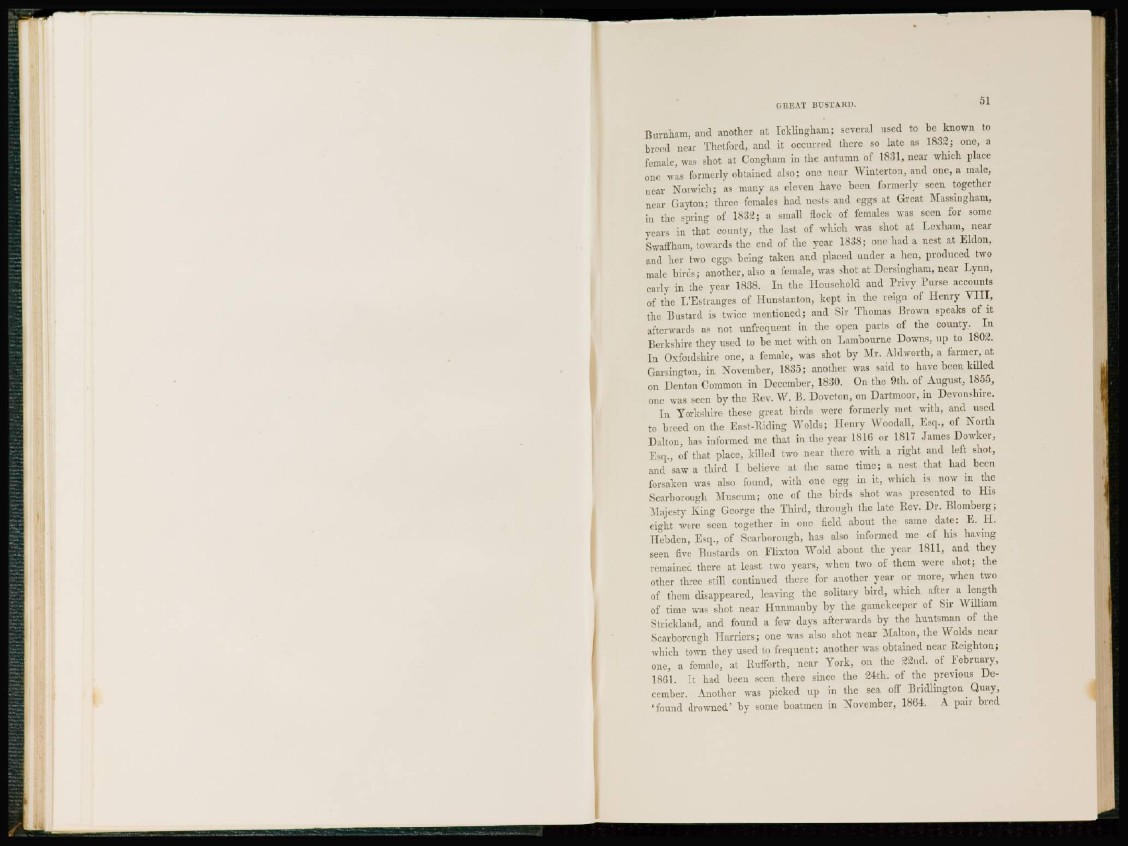
GREAT BTJSTARD- 51
Burnham, and another at Ickliugham; several used to be known to
breed near Thetford, and it occurred there so late as 1832; one, a
female, was shot at Congham in the autumn of 1831, near which place
one was formerly obtained also; one near Wintcrton, and one, a male,
near Norwich; as many as eleven have been formerly seen together
near Gayton; three females had nests and eggs at Great Massingham,
in the spring of 1832; a small flock of females was seen for some
years in that county, the last of which was shot at Lexham, near
Swaffham, towards the end of the year 1838; one had a nest at Eldon,
and her two eggs being taken and placed under a hen, produced two
male birds; another, also a female, was shot at Dersiugham, near Lynn,
early in the year 1838. In the Household and Privy Purse accounts
of the T/Estranges of Hunstanton, kept in the reign of Henry V I I I,
the Bustard is twice mentioned; and Sir Thomas Brown speaks of it
afterwards as not unfrequcnt in the open parts of the county. In
Berkshire they used to be met with on Lambourne Downs, u p to 1802.
I n Oxfordshire one, a female, was shot by Mr. Aid worth, a farmer, at
Garsington, in November, 1835; another was said to have been killed
on Denton Common in December, 1830. On the 9th. of August, 1855,
one was seen by t h e Rev. W . B. Doveton, on Dartmoor, in Devonshire.
In Yorkshire these great birds were formerly met with, and used
to breed on the East-Riding Wolds; Henry Woodall, Esq., of North
Dalton, has informed me that in the year 1816 or 1817 James Dowker,
Esq., of that place, killed two near there with a right and left shot,
and saw a third I believe at the same time; a nest that had been
forsaken was also found, with one egg in it, winch is now in the
Scarborough Museum; one of the birds shot was presented to His
Majesty King George the Third, through the late Rev. Dr. Blomberg;
eight were seen together in one field about the same date: E. H.
llebdcn, Esq., of Scarborough, has also informed me of his having
seen five Bustards on Flixton Wold about the year 1811, and they
remained there at least two years, when two of them were shot; the
other three still continued there for another year or more, when two
of them disappeared, leaving the solitary bird, which after a length
of time was shot near Hunmanby by the gamekeeper of Sir William
Strickland, and found a few days afterwards by the huntsman of the
Scarborough H a r r i e r s ; one was also shot near Malton, the Wolds near
which town they used to frequent; another was obtained near Heighten;
one, a female, at Rufforth, near York, on the 22nd. of February,
18G1. It had been seen there since the 24th. of the previous December.
Another was picked up in the sea off Bridlington Quay,
'found drowned' by some boatmen in November, 1804. A pair bred